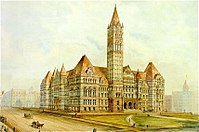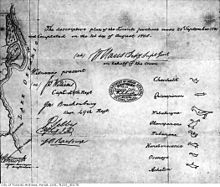
Etobicoke is an administrative district and former city within Toronto, Ontario, Canada. Comprising the city's west-end, Etobicoke is bordered on the south by Lake Ontario, on the east by the Humber River, on the west by Etobicoke Creek, the cities of Brampton, and Mississauga, the Toronto Pearson International Airport, and on the north by the city of Vaughan at Steeles Avenue West.

The Mississaugas are a group of First Nations peoples located in southern Ontario, Canada. They are a sub-group of the Ojibwe Nation.

Events from the year 1787 in Canada.

Six Nations is demographically the largest First Nations reserve in Canada. As of the end of 2017, it has a total of 27,276 members, 12,848 of whom live on the reserve. It is the only reserve in North America that has representatives of all six Haudenosaunee nations living together. These nations are the Mohawk, Cayuga, Onondaga, Oneida, Seneca and Tuscarora. Some Lenape live in the territory as well.
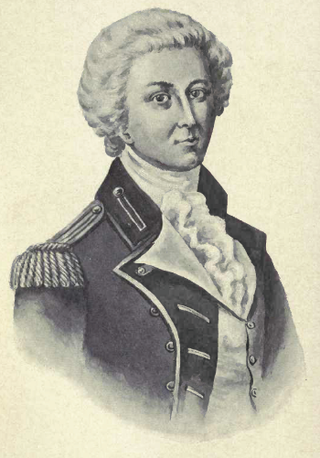
Samuel Bois Smith was a Loyalist British Army officer and politician. He was appointed to the Executive Council of Upper Canada and appointed Administrator of Upper Canada.

Lorne Park is a suburban residential neighbourhood located in southwestern Mississauga, Ontario, Canada, that was first established as a resort.
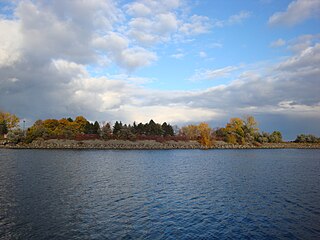
Lakeview is a neighbourhood in Mississauga in the Region of Peel, centred on Lakeshore Road in the extreme southeastern corner of the city, along the shore of Lake Ontario, between the larger neighbourhood of Port Credit to the west and the Long Branch neighbourhood of Toronto to the east.

Deseronto is a town in the Canadian province of Ontario, in Hastings County, located at the mouth of the Napanee River on the shore of the Bay of Quinte, on the northern side of Lake Ontario.
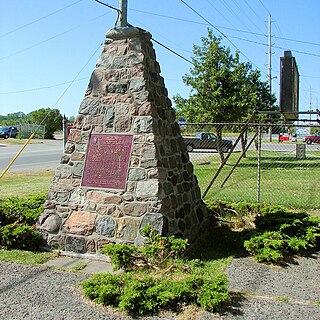
Carrying Place is a community straddling the Quinte West and Prince Edward County border that serves as a gateway to Prince Edward County, Ontario, Canada. Situated northwest of Picton and just south of Trenton, it was named for its location on the portage between the Bay of Quinte and Weller's Bay on Lake Ontario. The Loyalist Parkway passes through the community.
The Robinson Treaties are two treaties signed between the Ojibwa chiefs and the Crown in 1850 in the Province of Canada. The first treaty involved Ojibwa chiefs along the north shore of Lake Superior, and is known as the Robinson Superior Treaty. The second treaty, signed two days later, included Ojibwa chiefs from along the eastern and northern shores of Lake Huron, and is known as the Robinson Huron Treaty. The Wiikwemkoong First Nation did not sign either treaty, and their land is considered "unceded".

The Haldimand Proclamation was a decree that granted land to the Mohawk who had served on the British side during the American Revolution. The decree was issued by the Governor of the Province of Quebec, Frederick Haldimand, on October 25, 1784, three days after the Treaty of Fort Stanwix was signed between others of the Six Nations and the American government. The granted land had to be purchased from the Mississaugas of the Credit whose traditional territory spans much of modern-day Southwestern Ontario. On May 22, 1784 Col. John Butler was sent to negotiate the sale of approximately 3,000,000 acres of land located between Lakes Huron, Ontario, and Erie for £1180.00 from the Mississaugas of the Credit. Of the land ceded, some 550,000 acres were granted to the Mohawk nation in the Haldimand Proclamation. The sale by the Mississaugas of the Credit is also referred to as the "Between the Lakes Treaty."
Captain John Deserontyon, U.E.L was a Mohawk war chief allied with the British during the American Revolutionary War. He led his people to Upper Canada after the war, settling on land granted by the Crown at the Bay of Quinte in present-day Ontario. This reserve, initially settled primarily by Mohawk loyalists from the Lower Castle, is known as Tyendinaga Mohawk Territory, Ontario. Deseronto, Ontario is named for him.

Augustus Jones was a North American-born Upper Canadian farmer, land speculator, magistrate, militia captain and surveyor. Jones trained as a surveyor in New York City, and fled as a United Empire Loyalist to Upper Canada. In Upper Canada, he worked as a crown surveyor in the Nassau District, where he quickly rose to the position of Deputy Surveyor General, the highest position in a district of Upper Canada. He occupied that position from 1789 informally, and 1791 formally, until his retirement in 1799. During that time he laid down many of the township boundaries in the Niagara Peninsula and on the north shore of Lake Ontario. He led various teams that cut many of the first sideroads and concession roads into these areas, facilitating their settlement by European and American immigrants. Jones also surveyed the routes for Dundas Street and Yonge Street, and supervised their construction. After his retirement, Jones farmed first in Saltfleet Township, later moving to Brantford and finally an estate outside Paris named Cold Springs, where he died in 1836.

Alderville First Nation is a band of Mississaugas, a sub-nation of the Ojibways. The Alderville and Sugar Island 37A reserves belong to that First Nation band government.
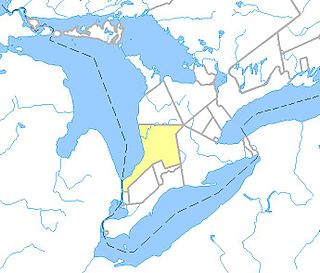
The Huron Tract Purchase also known as the Huron Block, registered as Crown Treaty Number 29, is a large area of land in southwestern Ontario bordering on Lake Huron to the west and Lake Erie to the east. The area spans the counties of Huron, Perth, Middlesex and present day Lambton County, Ontario in the province of Ontario.
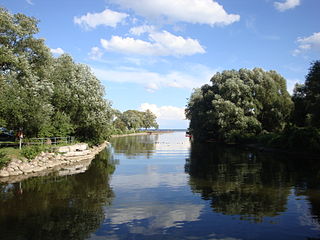
Marie Curtis Park is a public park in Toronto, Ontario, Canada. It is located at the mouth of the Etobicoke Creek on Lake Ontario in the Long Branch neighbourhood. Marie Curtis Park was built after the devastating floods of Hurricane Hazel in 1954 destroyed 56 homes and cottages on the site, leaving 1,868 persons homeless and 81 dead. It is named after Marie Curtis, the reeve of Long Branch at the time of its construction. Long Branch at the time was a separate village; it's now amalgamated into the City of Toronto government.

Tyendinaga Mohawk Territory is the main First Nation reserve of the Mohawks of the Bay of Quinte First Nation. The territory is located in Ontario east of Belleville on the Bay of Quinte. Tyendinaga is located near the site of the former Mohawk village of Ganneious.:10
The Crawford Purchase was an agreement that surrendered lands that extended west along the north shore of the St. Lawrence River and Lake Ontario from the Mississaugas to the British crown to enable Loyalist settlement in what is now a part of eastern Ontario, Canada. The agreement was made in 1783 in exchange for various items.

The Culbertson Tract Land Claim, located in the Canadian Province of Ontario in Hastings County, is a specific land claim originally submitted by the Mohawks of the Bay of Quinte in 1995. It covers 923 acres surrounding the Tyendinaga area and the majority of the Deseronto township. This claim is based on the loss of over 800 acres of land during the continued loyalist settlement during 1820-1843 which proved to be the loss of the majority of the land from the Simcoe Treaty.

John Collins was an influential Deputy Surveyor General in the Province of Canada shortly after it was captured by the British.
